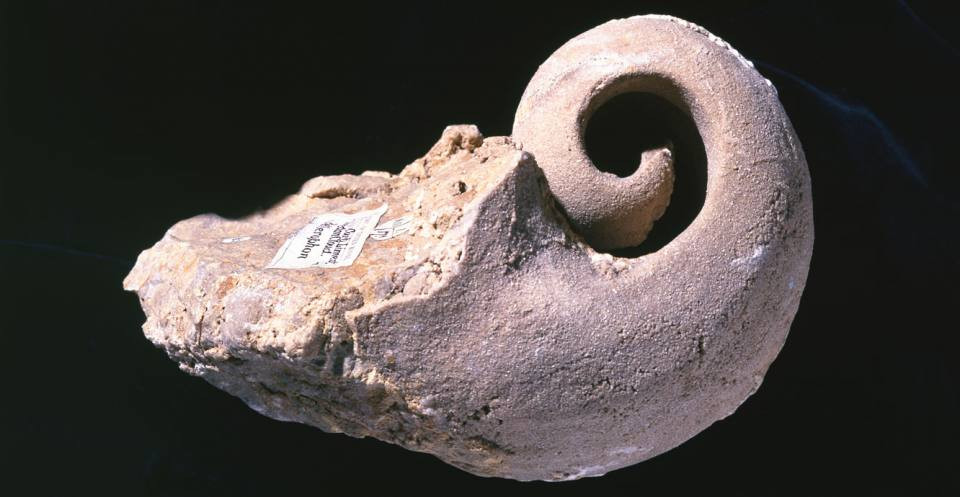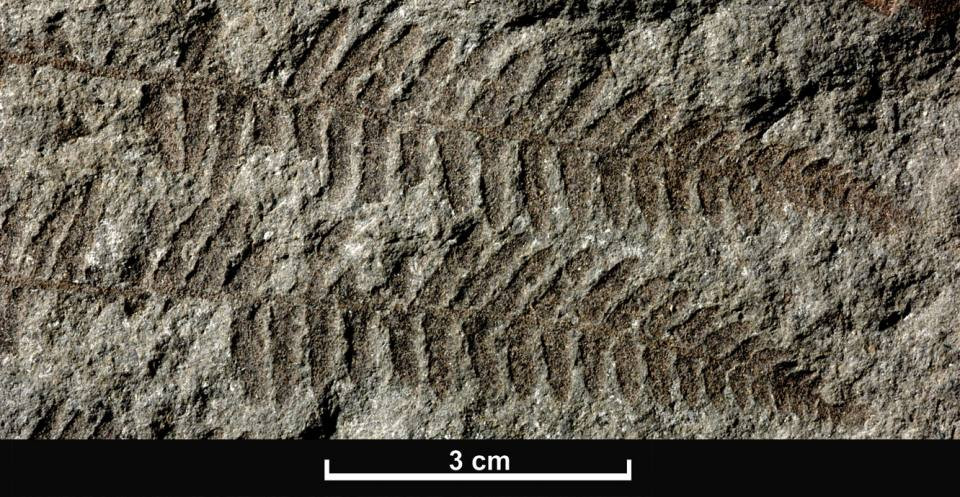How Do Fossils Form In Sedimentary Rocks? Fossils form in sedimentary rocks through a fascinating process involving burial, mineral replacement, and time. At rockscapes.net, we help you understand this natural history and appreciate how rocks tell the story of life on Earth. From petrification to preserved remains, discover the science behind these ancient treasures.
1. Understanding Fossils
Fossils are the preserved remains or traces of animals, plants, and other organisms from the remote past. These remnants are typically found embedded in sedimentary rocks. Fossils provide invaluable insights into the evolution of life, past environments, and geological history.
1.1 What Exactly Is a Fossil?
A fossil is any preserved trace of past life, typically more than 10,000 years old. This includes body fossils, which are the preserved remains of an organism’s body, and trace fossils, which are evidence of an organism’s activity, such as footprints or burrows.
1.2 Types of Fossils
- Body Fossils: These are the actual preserved remains of an organism, such as bones, shells, or teeth.
- Trace Fossils: These are the signs that organisms left behind, like footprints, burrows, and even fossilized dung (coprolites).
- Chemical Fossils: These involve chemical compounds that indicate the presence of past life.
1.3 Why Fossils Matter
Fossils serve as essential records of life’s history on Earth. They offer evidence of evolution, demonstrate the relationships between past and present organisms, and help us understand how environments have changed over millions of years. According to research from Arizona State University’s School of Earth and Space Exploration, fossils are crucial for understanding the interconnectedness of all life forms.
2. Sedimentary Rocks: The Cradle of Fossils
Sedimentary rocks are types of rock that are formed by the accumulation or deposition of mineral or organic particles at the Earth’s surface, followed by cementation. Sedimentation is the collective name for processes that cause these particles to settle in place. Sedimentary rocks are formed from pre-existing rocks or pieces of once-living organisms. They form from accumulations of sediments.
2.1 What Are Sedimentary Rocks?
Sedimentary rocks are formed from accumulated sediments like mineral or organic particles at the Earth’s surface. These sediments are then compressed and cemented together over millions of years.
2.2 Types of Sedimentary Rocks
- Clastic Sedimentary Rocks: Formed from the fragments of other rocks and minerals. Examples include sandstone, shale, and conglomerate.
- Chemical Sedimentary Rocks: Formed from minerals precipitated out of solution. Examples include limestone and rock salt.
- Organic Sedimentary Rocks: Formed from the accumulation of plant or animal debris. Coal is a prime example.
2.3 Why Sedimentary Rocks Are Ideal for Fossil Formation
The conditions in which sedimentary rocks form often allow for the preservation of organic material. Rapid burial by sediments protects remains from decay and erosion, creating an environment conducive to fossilization.
3. The Fossilization Process in Sedimentary Rocks
The formation of fossils in sedimentary rocks is a complex process that requires specific conditions. Here’s a step-by-step breakdown:
3.1 Death and Initial Burial
The process begins when an organism dies. For fossilization to occur, the remains must be quickly buried under layers of sediment, such as mud, sand, or volcanic ash. This rapid burial protects the remains from scavengers, decomposition, and surface weathering.
3.2 Sediment Accumulation
Over time, more layers of sediment accumulate on top of the buried remains. The weight of these layers compacts the sediment below, gradually turning it into sedimentary rock.
3.3 Mineralization
As groundwater seeps through the sedimentary layers, it carries dissolved minerals. These minerals can infiltrate the buried remains, gradually replacing the organic material with inorganic minerals like calcite, silica, or pyrite. This process, called permineralization, turns the remains into stone while preserving their original shape.
3.4 Preservation
If conditions are right, the mineralized remains can be preserved for millions of years within the sedimentary rock. The type of mineral and the specific environmental conditions determine the quality of preservation.
3.5 Exposure
Eventually, geological processes like erosion, uplift, and plate tectonics can expose the fossil-bearing sedimentary rock at the Earth’s surface. This allows paleontologists and enthusiasts to discover and study the fossils.
4. Types of Fossilization in Sedimentary Rocks
Several different processes can lead to fossil formation in sedimentary rocks, each with its unique characteristics:
4.1 Permineralization
Permineralization is the most common method of fossilization. It occurs when mineral-rich fluids penetrate porous remains, filling the spaces and eventually replacing the original organic material with minerals.
4.2 Replacement
In replacement, the original material of the remains is completely replaced by minerals. The new minerals retain the exact shape and structure of the original organism.
4.3 Molds and Casts
When the original remains dissolve away entirely, they can leave a void in the surrounding rock. This void is called a mold. If the mold is later filled with sediment or minerals, it forms a cast of the original organism.
4.4 Compression
Compression occurs when the remains are flattened by the weight of overlying sediments. This is particularly common with plant fossils, where the plant material is compressed into a thin, carbon-rich film.
4.5 Impression
Impressions are similar to molds but involve only a surface imprint of the organism. These are common in fine-grained sediments like shale.
5. Factors Affecting Fossil Formation
Several factors influence whether an organism will become fossilized in sedimentary rocks:
5.1 Type of Organism
Organisms with hard parts, such as bones, shells, and teeth, are more likely to be preserved than soft-bodied organisms, which tend to decay quickly.
5.2 Environmental Conditions
Rapid burial in a sediment-rich environment is crucial for fossilization. Marine environments, river deltas, and lakebeds are particularly conducive to fossil formation.
5.3 Sediment Type
Fine-grained sediments like mud and silt provide better preservation than coarse-grained sediments like sand and gravel.
5.4 Chemical Conditions
The presence of certain minerals in the groundwater can enhance fossilization, while acidic conditions can dissolve remains.
6. The Role of Rockscapes.net in Appreciating Fossils
At rockscapes.net, we are dedicated to helping you explore and appreciate the fascinating world of rocks and fossils. Our resources and expertise can enhance your understanding and enjoyment of these natural wonders.
6.1 Educational Resources
We provide comprehensive information on the formation, types, and significance of fossils. Our articles, guides, and resources are designed to educate and inspire enthusiasts of all ages.
6.2 Rock and Mineral Identification
If you find a rock or mineral that you suspect might contain a fossil, we can help you identify it. Our experts can provide insights into the geological context and potential significance of your find.
6.3 Landscaping with Fossil-Bearing Rocks
Incorporate the beauty and history of fossils into your landscape design. We offer advice and resources on sourcing and using fossil-bearing rocks to create stunning and educational outdoor spaces.
7. Where to Find Fossils in Sedimentary Rocks in the USA
The United States is rich in sedimentary rock formations that are known for their fossil deposits. Here are some notable locations:
7.1 The Green River Formation (Wyoming, Colorado, Utah)
This formation is famous for its incredibly detailed fish fossils, as well as plant and insect fossils. The Green River Formation represents a series of ancient lakes that existed around 50 million years ago.
7.2 The La Brea Tar Pits (Los Angeles, California)
While not a typical sedimentary rock formation, the La Brea Tar Pits have preserved an extraordinary collection of Ice Age fossils, including mammoths, saber-toothed cats, and dire wolves. The asphalt seeps have acted as natural traps, preserving bones in remarkable condition.
7.3 The Morrison Formation (Western USA)
This formation is renowned for its dinosaur fossils, including iconic species like Stegosaurus, Apatosaurus, and Allosaurus. The Morrison Formation dates back to the Late Jurassic period.
7.4 The Calvert Cliffs (Maryland)
The Calvert Cliffs along the Chesapeake Bay are rich in Miocene-epoch fossils, including marine mammals, sharks, and mollusks. The cliffs are composed of sedimentary layers that have been eroding for millions of years, revealing a wealth of fossil material.
7.5 The Agate Fossil Beds National Monument (Nebraska)
This national monument preserves a significant concentration of Miocene mammal fossils, including rhinoceroses, horses, and camels. The fossils are found in fine-grained sandstone layers.
7.6 Fossil Park (New Jersey)
At Fossil Park, visitors can discover fossils of clams, snails, crustaceans and more. It is operated by the Rowan University and open to the public.
8. Ethical Fossil Collecting
If you plan to collect fossils, it’s essential to do so ethically and responsibly:
8.1 Know the Laws
Familiarize yourself with the laws and regulations regarding fossil collecting in your area. Some areas may be protected, and collecting may be prohibited.
8.2 Obtain Permission
Always obtain permission from landowners before collecting fossils on private property.
8.3 Collect Responsibly
Avoid damaging the surrounding environment while collecting. Fill in any holes you dig and leave the area as you found it.
8.4 Document Your Finds
Keep detailed records of where you found each fossil. This information is valuable for scientific research.
8.5 Consider Contributing to Science
If you find a particularly significant fossil, consider donating it to a museum or research institution.
9. Common Fossils Found in Sedimentary Rocks
Many types of fossils can be found in sedimentary rocks, depending on the geological age and environmental conditions of the formation. Here are some of the most common:
9.1 Marine Invertebrates
- Trilobites: Extinct marine arthropods that lived during the Paleozoic era.
- Ammonites: Extinct cephalopods with coiled shells, common in Mesozoic rocks.
- Brachiopods: Marine animals with hinged shells, similar to clams.
- Gastropods: Snails and slugs, often preserved as molds and casts.
- Bivalves: Clams, oysters, and mussels, common in both marine and freshwater sediments.
- Echinoderms: Starfish, sea urchins, and crinoids, often found in marine limestones.
 This image is a mould of an ancient snail or slug called Bellerophon, a gastropod. Fossils can form when mould of the interior of the shell is made by water-borne minerals percolating through it, but later the shell material dissolves away.
This image is a mould of an ancient snail or slug called Bellerophon, a gastropod. Fossils can form when mould of the interior of the shell is made by water-borne minerals percolating through it, but later the shell material dissolves away.
9.2 Plants
- Leaves and Stems: Often preserved as compressions in shale and coal.
- Fossil Wood: Petrified wood, where the original wood has been replaced by minerals.
- Pollen and Spores: Microscopic fossils that can provide insights into ancient plant communities.
 Plant leaves and ferns are good examples of fossils produced by compression. This image shows Coniopteris, which is a type of true fern, or pteropsid, fossil from the Jurassic Period.
Plant leaves and ferns are good examples of fossils produced by compression. This image shows Coniopteris, which is a type of true fern, or pteropsid, fossil from the Jurassic Period.
9.3 Vertebrates
- Fish: Often found in lake and marine sediments.
- Reptiles: Dinosaur bones and footprints are found in Mesozoic rocks.
- Mammals: Bones and teeth of mammals can be found in Cenozoic sediments.
9.4 Trace Fossils
- Footprints: Dinosaur footprints, tracks of early humans.
- Burrows: Evidence of ancient worms, crustaceans, and other burrowing animals.
- Coprolites: Fossilized dung, can provide information about the diet of ancient animals.
10. Tools and Techniques for Fossil Hunting
If you’re interested in fossil hunting, here are some essential tools and techniques to get you started:
10.1 Essential Tools
- Geological Hammer: For breaking rocks and exposing fossils.
- Chisels: For carefully removing fossils from rock.
- Brushes: For cleaning fossils.
- Magnifying Glass: For examining small details.
- Safety Glasses: To protect your eyes from flying rock fragments.
- Gloves: To protect your hands.
- Notebook and Pencil: To record your finds.
- Camera: To document your discoveries.
10.2 Techniques for Finding Fossils
- Research: Learn about the geology of the area you plan to explore.
- Surface Hunting: Look for fossils exposed on the surface of the ground.
- Rock Splitting: Carefully split sedimentary rocks to reveal hidden fossils.
- Screen Washing: Wash sediments through a screen to find small fossils.
- Patience: Fossil hunting requires patience and persistence.
11. Current Trends in Paleontology
Paleontology is a constantly evolving field, with new discoveries and technologies changing our understanding of ancient life. Here are some current trends:
11.1 Advanced Imaging Techniques
- CT Scanning: Allows paleontologists to create 3D models of fossils without damaging them.
- Microscopy: Advanced microscopes reveal microscopic details of fossils.
11.2 Molecular Paleontology
- DNA Analysis: In rare cases, DNA can be extracted from fossils, providing insights into the genetic relationships of extinct organisms.
- Protein Analysis: Analyzing proteins in fossils can also provide valuable information.
11.3 Biogeochemistry
- Isotope Analysis: Analyzing isotopes in fossils can reveal information about ancient diets and environments.
11.4 Digital Paleontology
- 3D Printing: Creating 3D printed models of fossils for research and education.
- Virtual Reality: Immersive virtual reality experiences that allow people to explore ancient environments.
12. The Future of Fossil Discovery
As technology advances and more areas are explored, the future of fossil discovery looks promising. Here are some exciting possibilities:
12.1 Exploring Undiscovered Regions
Many parts of the world remain unexplored for fossils. Remote areas of Africa, Asia, and South America hold great potential for new discoveries.
12.2 Deep-Sea Paleontology
Exploring the deep sea could reveal unique fossils of marine organisms that have never been seen before.
12.3 Using Artificial Intelligence
AI could be used to analyze large datasets and identify promising areas for fossil exploration.
13. Why Choose Rockscapes.net for Your Landscaping Needs?
When it comes to landscaping, choosing the right materials and designs can make all the difference. Rockscapes.net offers a range of services tailored to meet your landscaping needs:
13.1 Wide Selection of Rocks and Stones
From decorative stones to functional boulders, Rockscapes.net provides a diverse selection of rocks and stones to enhance any landscape.
13.2 Expert Design Advice
Our team of experienced designers can help you create a landscape that is both beautiful and sustainable. We offer personalized consultations to understand your vision and bring it to life.
13.3 Quality Materials
We source our materials from reputable suppliers, ensuring that you receive high-quality rocks and stones that will stand the test of time.
13.4 Sustainable Practices
Rockscapes.net is committed to sustainable landscaping practices. We use eco-friendly materials and techniques to minimize our environmental impact.
14. Customer Success Stories
Don’t just take our word for it. Here are some testimonials from satisfied customers who have transformed their landscapes with Rockscapes.net:
14.1 Transforming a Backyard in Arizona
“Rockscapes.net helped us turn our barren backyard into a desert oasis. The native stones and drought-resistant plants have created a beautiful and low-maintenance space that we love.” – Sarah, Phoenix, AZ
14.2 Creating a Natural Stone Pathway in California
“The team at Rockscapes.net designed and installed a stunning natural stone pathway in our garden. The craftsmanship is impeccable, and the pathway has added so much character to our property.” – Mark, Los Angeles, CA
14.3 Designing a Rock Garden in Colorado
“We wanted to create a rock garden that would complement our mountain home. Rockscapes.net provided the perfect selection of stones and plants, and their design expertise was invaluable.” – Emily, Denver, CO
15. Contact Rockscapes.net
Ready to start your landscaping project? Contact Rockscapes.net today to schedule a consultation.
- Address: 1151 S Forest Ave, Tempe, AZ 85281, United States
- Phone: +1 (480) 965-9011
- Website: rockscapes.net
16. Conclusion
Understanding how fossils form in sedimentary rocks reveals the amazing processes that have shaped our planet. At rockscapes.net, we invite you to explore the beauty and history of rocks and landscapes. Whether you’re designing a garden, learning about geology, or planning a fossil-hunting trip, we’re here to support you every step of the way. Visit rockscapes.net today to discover a wealth of ideas, information, and inspiration.
17. Frequently Asked Questions (FAQs)
17.1 What Are the Best Places to Find Fossils?
Good places to find fossils include sedimentary rock formations, riverbanks, and coastal cliffs. Research local geology to find potential sites.
17.2 How Can I Identify a Fossil?
Fossils often have a different color and texture than the surrounding rock. Look for recognizable shapes of organisms, such as shells, bones, or leaves.
17.3 What Tools Do I Need for Fossil Hunting?
Essential tools include a geological hammer, chisels, brushes, safety glasses, and a notebook.
17.4 Is It Legal to Collect Fossils?
Laws regarding fossil collecting vary by location. Check local regulations and obtain permission before collecting on private land.
17.5 How Are Fossils Dated?
Fossils are typically dated using radiometric dating methods and by examining the age of the surrounding rock layers.
17.6 Can Fossils Be Found in All Types of Rocks?
Fossils are most commonly found in sedimentary rocks, but they can occasionally be found in low-grade metamorphic rocks.
17.7 What Is the Oldest Fossil Ever Found?
The oldest known fossils are microscopic bacteria-like organisms found in rocks that are over 3.5 billion years old.
17.8 How Do Paleontologists Study Fossils?
Paleontologists use a variety of techniques, including microscopy, CT scanning, and DNA analysis, to study fossils.
17.9 What Can Fossils Tell Us About the Past?
Fossils can provide insights into the evolution of life, past environments, and the history of our planet.
17.10 How Can I Get Involved in Paleontology?
You can get involved by joining a local fossil club, volunteering at a museum, or taking paleontology courses.
Discover the wonders of fossil formation and sedimentary rocks with rockscapes.net. Explore our site for more information and inspiration!
